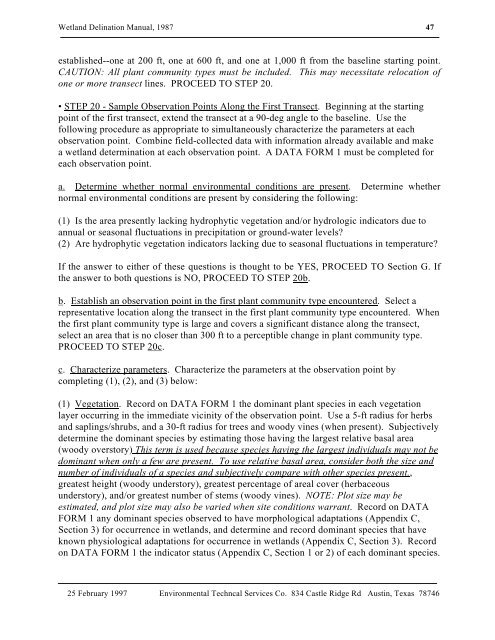1987 Wetland Delineation Manual - The Wetlands Regulation Center
1987 Wetland Delineation Manual - The Wetlands Regulation Center
1987 Wetland Delineation Manual - The Wetlands Regulation Center
You also want an ePaper? Increase the reach of your titles
YUMPU automatically turns print PDFs into web optimized ePapers that Google loves.
<strong>Wetland</strong> Delination <strong>Manual</strong>, <strong>1987</strong> 47<br />
established--one at 200 ft, one at 600 ft, and one at 1,000 ft from the baseline starting point.<br />
CAUTION: All plant community types must be included. This may necessitate relocation of<br />
one or more transect lines. PROCEED TO STEP 20.<br />
• STEP 20 - Sample Observation Points Along the First Transect. Beginning at the starting<br />
point of the first transect, extend the transect at a 90-deg angle to the baseline. Use the<br />
following procedure as appropriate to simultaneously characterize the parameters at each<br />
observation point. Combine field-collected data with information already available and make<br />
a wetland determination at each observation point. A DATA FORM 1 must be completed for<br />
each observation point.<br />
a. Determine whether normal environmental conditions are present. Determine whether<br />
normal environmental conditions are present by considering the following:<br />
(1) Is the area presently lacking hydrophytic vegetation and/or hydrologic indicators due to<br />
annual or seasonal fluctuations in precipitation or ground-water levels?<br />
(2) Are hydrophytic vegetation indicators lacking due to seasonal fluctuations in temperature?<br />
If the answer to either of these questions is thought to be YES, PROCEED TO Section G. If<br />
the answer to both questions is NO, PROCEED TO STEP 20b.<br />
b. Establish an observation point in the first plant community type encountered. Select a<br />
representative location along the transect in the first plant community type encountered. When<br />
the first plant community type is large and covers a significant distance along the transect,<br />
select an area that is no closer than 300 ft to a perceptible change in plant community type.<br />
PROCEED TO STEP 20c.<br />
c. Characterize parameters. Characterize the parameters at the observation point by<br />
completing (1), (2), and (3) below:<br />
(1) Vegetation. Record on DATA FORM 1 the dominant plant species in each vegetation<br />
layer occurring in the immediate vicinity of the observation point. Use a 5-ft radius for herbs<br />
and saplings/shrubs, and a 30-ft radius for trees and woody vines (when present). Subjectively<br />
determine the dominant species by estimating those having the largest relative basal area<br />
(woody overstory) This term is used because species having the largest individuals may not be<br />
dominant when only a few are present. To use relative basal area, consider both the size and<br />
number of individuals of a species and subjectively compare with other species present.,<br />
greatest height (woody understory), greatest percentage of areal cover (herbaceous<br />
understory), and/or greatest number of stems (woody vines). NOTE: Plot size may be<br />
estimated, and plot size may also be varied when site conditions warrant. Record on DATA<br />
FORM 1 any dominant species observed to have morphological adaptations (Appendix C,<br />
Section 3) for occurrence in wetlands, and determine and record dominant species that have<br />
known physiological adaptations for occurrence in wetlands (Appendix C, Section 3). Record<br />
on DATA FORM 1 the indicator status (Appendix C, Section 1 or 2) of each dominant species.<br />
25 February 1997 Environmental Techncal Services Co. 834 Castle Ridge Rd Austin, Texas 78746


